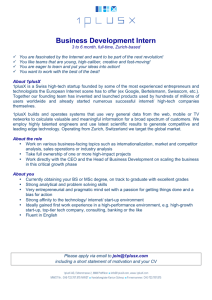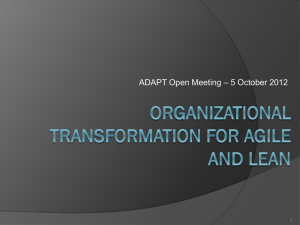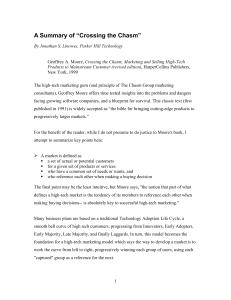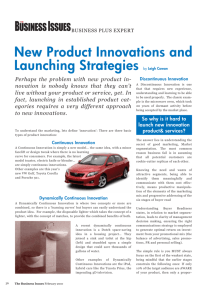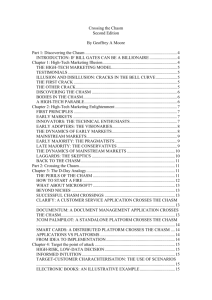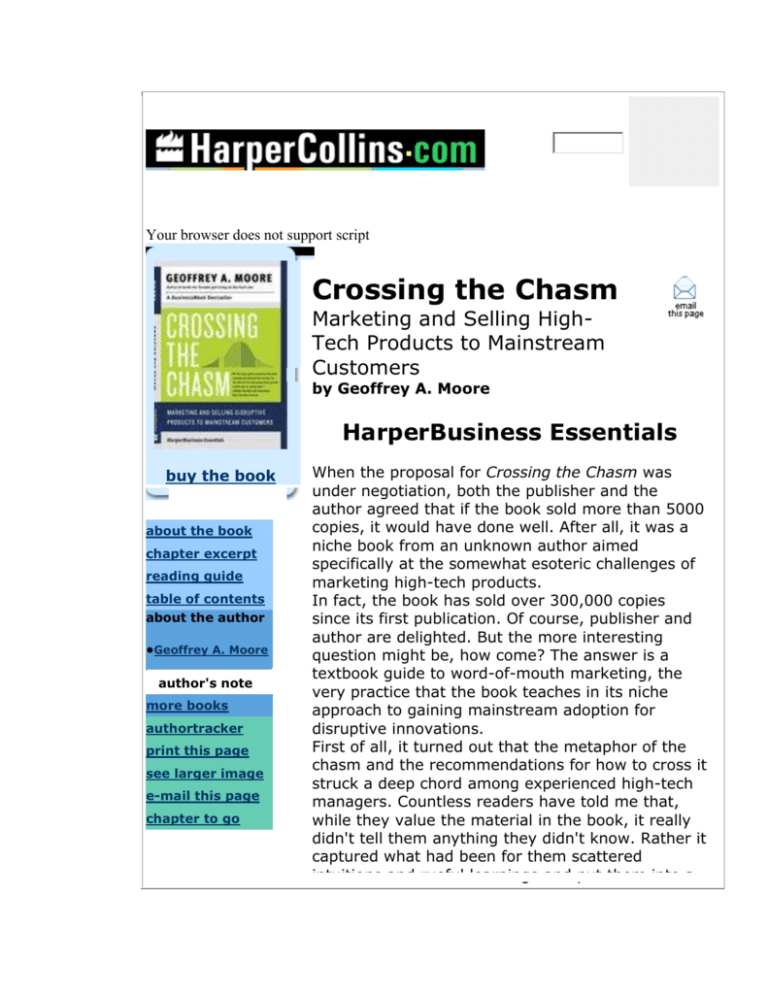
Your browser does not support script
Crossing the Chasm
Marketing and Selling HighTech Products to Mainstream
Customers
by Geoffrey A. Moore
HarperBusiness Essentials
buy the book
about the book
chapter excerpt
reading guide
table of contents
about the author
•Geoffrey A. Moore
author's note
more books
authortracker
print this page
see larger image
e-mail this page
chapter to go
When the proposal for Crossing the Chasm was
under negotiation, both the publisher and the
author agreed that if the book sold more than 5000
copies, it would have done well. After all, it was a
niche book from an unknown author aimed
specifically at the somewhat esoteric challenges of
marketing high-tech products.
In fact, the book has sold over 300,000 copies
since its first publication. Of course, publisher and
author are delighted. But the more interesting
question might be, how come? The answer is a
textbook guide to word-of-mouth marketing, the
very practice that the book teaches in its niche
approach to gaining mainstream adoption for
disruptive innovations.
First of all, it turned out that the metaphor of the
chasm and the recommendations for how to cross it
struck a deep chord among experienced high-tech
managers. Countless readers have told me that,
while they value the material in the book, it really
didn't tell them anything they didn't know. Rather it
captured what had been for them scattered
intuitions and rueful learnings and put them into a
coherent set of frameworks that could be used for
future decision making.
This, in turn, caused them to pass it along to
colleagues, as much to proliferate the vocabulary
as anything else. Thus the book left the marketing
department and began to find its way to the
engineering section where a whole lot of readers
claimed it was the first marketing book they didn't
throw away after reading the early chapters. Praise
from engineers is praise indeed, and this author
was deeply grateful for this response.
This unusual turn of events also caught the eye of
the venture capital community which in turn
became a channel for more book sales. They saw in
the new vocabulary a means to begin a market
development dialog with their engineering-oriented
entrepreneurs. Indeed for whole companies it
became required reading, just to get everyone on
the same page.
Professors at business schools then picked it up for
their courses in entrepreneurial marketing, which
was becoming all the rage in the years after the
book's first release. Students liked the book
because it was both descriptive and prescriptive in
clear terms, largely because it communicates the
core of its arguments through metaphors, mixed
though they often be. If you bought into the
analogies, you pretty much had the essence of the
book, and reading it was just a reconfirmation of
what you already knew.
And so things went swimmingly until around 1997
or so when students began asking, "Who is Ashton
Tate or Cullinet? What is Wordstar or Ingres?" The
examples, which are key to any argument by
analogy, had grown long in the tooth. And so a
revised edition came out, keeping the argument
largely in tact, but substituting 1990's companies
for their 1980's predecessors, further affirming the
author's belief that chasms are a perennial feature
of the tech sector's landscape.
And that brings us to today. In addition to a revised
edition, the book has spawned two sequels of sorts:
Inside the Tornado, which covers the opposite of
the chasm challenge -- how to market during
hypergrowth, and Living on the Fault Line, which
addresses how incumbent market leaders must
respond to new technology challenges. It also
created a platform for a fourth book, The Gorilla
Game, co-authored with Paul Johnson and Tom
Kippola, about how these same dynamics play out
in the stock market valuations for technology
companies. And now in 2002 Harpers will be
releasing the first wholly non-Moore entry into the
chasm fray, The Chasm Companion, by my
colleague Paul Wiefels.
In short, chasm-writing and reading has become a
cottage industry of sorts, and the technology sector
has demonstrated infinite patience in absorbing its
unending slew of metaphors, from bowling alleys,
tornadoes, and Main Street to gorillas, chimps,
kings, and serfs, to GAP, CAP, core, and context, to
who knows what next. All the author can say to this
is that he tries find whatever words can best
capture the dynamics of the real-life situations his
clients find themselves in.
And that leads to a final thought. Books are a
collaboration between author and editor, and I am
afraid I have worn out several in this journey,
beginning with Virginia Smith who championed
Crossing the Chasm way back when, and
subsequently including Kirsten Sandberg and now
Dave Conti. HarperBusiness continues to bear with
me, and I with it, so the real question is, how long
will the reading public bear with the combination. I
hope it will be for a long time to come.
Geoffrey Moore
April 2002
Imprint: HarperBusiness; ISBN: 0060517123;
On Sale: 08/20/2002; Format: Trade PB;
Subformat: ; Length: ; Trimsize: 5 5/16 x 8;
Pages: 256; $17.95; $27.50(CAN)
Buy The Book | About The Book | Back To Top
© 2004, HarperCollins Publishers.
Crossin
g the
Chasm
Marketing
and Selling
High-Tech
Products to
Mainstream
Customers
by Geoffrey A.
Moore
Chapter Excerpt
High-Tech Marketing
Illusion
As the revised edition of this book is being written, it is 1998, and for this time we have seen a commercial release of the electric car. General
Motors makes one, and Ford and Chrysler are sure to follow. Let's assume the cars work like any other, except they are quieter and better for
the environment. Now the question is: When are you going to buy one?
The Technology Adoption Life Cycle
Your answer to the preceding question will tell a lot about how you relate to the Technology Adoption Life Cycle., a model for understanding
the acceptance of new products. If your answer is, "Not until hell freezes over," you are probably a very late adopter of technology, what we
call in the model a laggard. If your answer is, "When I have seen electric cars prove themselves and when there are enough service stations
on the road," you might be a middle-of-the-road adopter, or in the model, the early majority. If you say, "Not until most people have made
the switch and it becomes really inconvenient to drive a gasoline car," you are probably more of a follower, a member of the late majority. If,
on the.other hand, you want to be the first one on your block with an electric car, you are apt to be an innovator or an early adopter.
In a moment we are going to take a look at these labels in greater detail, but first we need to understand their significance. It turns out our
attitude toward technology adoption becomes significant--at least in a marketing sense--any time we are introduced to products that require
us to change our current mode of behavior or to modify other products and services we rely on. In academic terms, such change-sensitive
products are called discontinuous innovations. The contrasting term, continuous innovations, refers to the normal upgrading, of products that
does not require us to change behavior.
For example, when Crest promises you whiter teeth, that is a continuous innovation. You still are brushing the same teeth in the same way
with the same toothbrush. When Ford's new Taurus promises better mileage, when Dell's latest computer promises faster processing times
and more storage space, or when Sony promises sharper and brighter TV pictures, these are all continuous innovations. As a consumer, you
don't have to change your ways in order to take advantage of these improvements.
On the other hand, if the Sony were a high-definition TV, it would be incompatible with today's broadcasting standards, which,would require
you to seek out special sources of programming. This would be a discontinuous innovation because you would have to change your normal
TV-viewing behavior. Similarly if the new Dell computer were to come with the Be operating system, it would be incompatible with today's
software base. Again, you would be required to seek out a whole new set of software, thereby classifying this too as a discontinuous
innovation. Or if the new Ford car, as we just noted, required electricity instead of gasoline, or if the new toothpaste were a mouthwash that
did riot use a toothbrush, then once again you would have a product incompatible with your current infrastructure of supporting components.
In all these cases, the innovation demands significant changes by not only the consumer but also the infrastructure. That, is how and why
such innovations come to be called discontinuous.
Between continuous and discontinuous hes a spectrum of demands for change. TV dinners, unlike microwave dinners, didnot require the
purchase of a new oven, but they did require the purchase of more freezer space. Color-TV programming did not, like VCRs, require 'mvestinr
in and mastering a new technology, but they did require buying a new TV and learmng more about turning and antennas than many of us
wanted to learn. The special washing instructions for certain fabrics, the special street lanes reserved for bicycle riders, the special dialing
instructions for calling overseas--all represent some new level of demand on the consumer to absorb a chdn e in behavior. Sooner or later, all
businesses must make these demands. And so it is that all businesses can profit,by lessons, from high-tech industries.
Whereas other industries introduce discontinuous innovations only occasionally and with much trepidation, high-tech en@ terprises do so
routinely and as confidently as a born-again Christian holding four aces. From their inception, therefore, high-tech industries needed a
marketing model that coped effectively with this type of product introduction. Thus the Technology Adoption Life Cycle became central to the
entire sector's approach to marketing. (People are usually amused to learn that the original research that gave rise to this model was done.
on the adoption of new strains of seed potatoes among American farmers. Despite these,agrarian roots, however, the model has thoroughly
transplanted itself into the soil of Silicon Valley.)
The model describes the market penetration of any new technology product in terms. of a progression in the types of consumers it attract
throughout its useful life:
As you can see, we have a bell curve. The divisions in the curve are roughly equivalent to where standard deviations would fall. That is, the
early majority and the late majority fall within one standard deviation of the mean, the early adopters and the laggards within two, and way
out there, at the very onset of a new technology, about three standard deviations from the norm, are the innovators.
The groups are distinguished from each other by their characteristic response to a discontinuous innovation based on a new technology. Each
group represents a unique psychographic profile--a combination of psychology and demographics that makes it marketing responses different
from those of the other groups. Understanding each profile and its relationship to its neighbors is a critical component of high-tech marketing
lore.
The foregoing is excerpted from Crossing the Chasm by Geoffrey A. Moore. All rights reserved. No part of this book may be used or
reproduced without written permission from HarperCollins Publishers, 10 East 53rd Street, New York, NY 10022
Imprint: HarperBusiness; ISBN: 0060517123; On Sale: 08/20/2002; Format: Trade PB; Subformat: ; Length: ; Trimsize: 5 5/16 x 8;
Pages: 256; $17.95; $27.50(CAN)


